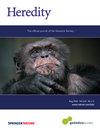EMIBD9:估计9个浓缩IBD系数,近交和标记基因型的相关性。
IF 3.9
2区 生物学
Q2 ECOLOGY
引用次数: 0
摘要
EMIBD9是一个计算机程序,实现两种似然方法,用于估计一对个体之间基因型数据的9个浓缩IBD系数Δ = {Δ1, Δ2,…,Δ9}。然后根据估计的Δ计算个体之间的近交系数和亲缘关系系数(或亲属系数)。一种方法被设计用于小样本或含有高比例近亲的样本,在这些样本中,假设有大量非近亲繁殖和无亲缘关系的个体,就无法很好地估计等位基因频率及其功率或产物。采用期望最大化(EM)算法对Δ和等位基因频率进行联合迭代估计。另一种方法被设计用于包含很少近亲的大量个体样本。它是快速的,因为它像所有以前的估计器一样,只估计Δ,而不通过EM算法计算推断的相关性来对等位基因频率进行迭代更新。EMIBD9为多种计算机平台(Windows、Mac和Linux)实现了这两种方法,Windows版本有一个GUI,便于数据输入和结果可视化。GUI还可以用于模拟基因型数据,用于研究影响相关性估计精度的因素,优化相关性研究的实验设计,并比较不同相关性估计器的性能。本文章由计算机程序翻译,如有差异,请以英文原文为准。

EMIBD9: Estimating 9 condensed IBD coefficients, inbreeding and relatedness from marker genotypes
EMIBD9 is a computer programme implementing two likelihood methods for estimating the 9 condensed IBD coefficients, Δ = {Δ1, Δ2, …, Δ9}, between a pair of individuals from their genotype data. Inbreeding coefficients of and relatedness (or kinship coefficient) between individuals are then calculated from the estimated Δ. One method is designed to apply to a small sample or a sample containing a high proportion of close relatives where allele frequencies and their powers or products are poorly estimated by assuming a large sample of non-inbred and unrelated individuals. It adopts an expectation maximisation (EM) algorithm to estimate both Δ and allele frequencies jointly and iteratively. The other method is designed to apply to a large sample of individuals containing few close relatives. It is fast because it, like all previous estimators, estimates Δ only and does not make iterative updates of allele frequencies by accounting for the inferred relatedness through the EM algorithm. EMIBD9 has both methods implemented for multiple computer platforms (Windows, Mac and Linux), and the Windows version has a GUI that facilitates data input and results visualisation. The GUI can also be used to simulate genotype data which are used to investigate factors affecting relatedness estimation accuracy, to optimise the experimental design of a relatedness study, and to compare the performance of different relatedness estimators.
求助全文
通过发布文献求助,成功后即可免费获取论文全文。
去求助
来源期刊

Heredity
生物-进化生物学
CiteScore
7.50
自引率
2.60%
发文量
84
审稿时长
4-8 weeks
期刊介绍:
Heredity is the official journal of the Genetics Society. It covers a broad range of topics within the field of genetics and therefore papers must address conceptual or applied issues of interest to the journal''s wide readership
 求助内容:
求助内容: 应助结果提醒方式:
应助结果提醒方式:


